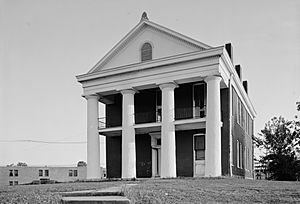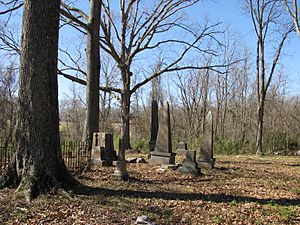Oakland College (Mississippi) facts for kids

Main façade of Belles Lettres, 1972
|
|
| Type | Private college |
|---|---|
| Active | 1830–1871 |
| Founder | Dr. Jeremiah Chamberlain |
|
Religious affiliation
|
Presbyterian |
| Location |
Near Rodney
,
31°52′33.5″N 91°08′24.1″W / 31.875972°N 91.140028°W |
| Campus | Rural town, 250 acres (0.39 sq mi; 101.17 ha) |
Oakland College was a private college located near Rodney, Mississippi. Dr. Jeremiah Chamberlain started the school in 1830. It was connected with the Presbyterian Church. The college closed during the period known as Reconstruction. Today, its former campus is part of the Alcorn State University Historic District.
Contents
Discovering Oakland College's Past
How the College Began
The Presbyterian Church founded Oakland College in 1830. It was a school for young men. They hired Dr. Jeremiah Chamberlain as the first President. He was a Presbyterian minister. Dr. Chamberlain had studied at Dickinson College and Princeton Theological Seminary. He had also led other colleges before coming to Oakland.
Life at Oakland College Before the Civil War
Wealthy landowners helped fund Oakland College. These included Rush Nutt, Smith Daniell, Isaac Ross, and David Hunt. Another person, John Ker, gave US$25,000 for a special teaching position in theology. The land for the college, about 250 acres, was a gift from Robert Cochran.
The Oakland Memorial Chapel was built in 1838. It was used as a chapel and a library. It also had classrooms and offices. In 1976, this chapel became a National Historic Landmark. Over time, more buildings were added. These included houses for the president and professors. There were also 15 small buildings for students to live in.
The first class at Oakland College started on May 14, 1830. It took place at a private home with only three students. Six months later, 22 students were enrolled. More than 1,000 students attended the college over the years. Many became ministers, lawyers, and doctors.
President Chamberlain believed in ending slavery. Sadly, he was killed by a local landowner who supported slavery. The landowner also died a week later.
Oakland College During the Civil War
Oakland College stayed open until the American Civil War began in 1861. The college faced money problems before the war. During the war, many students and teachers joined the Confederate States Army. Some were killed for supporting the Union. The campus was used as a military camp. Its buildings were badly damaged.
After the war, Rev. John Calvin became the fifth President. But he died soon after. The college then closed down for a while.
The College After the War
In 1871, the state of Mississippi bought the campus. They paid US$40,000 for it.
Exploring the College Grounds
A cemetery and a historical marker are on the western side of the old campus. Dr. Jeremiah Chamberlain, his wife, and his four daughters are buried there. His tombstone calls him "the beloved father of Oakland College." A tall monument was also built to honor Chamberlain.
Oakland College's Lasting Impact
After the Civil War, the state of Mississippi bought the campus. They used it to create Alcorn State University. This new university was named after Governor James L. Alcorn. It became a land-grant institution and a historically black college. This was the first black land-grant college in the United States. Congress required states to create such colleges. This was to ensure all students had chances for education.
Later, in 1879, the Presbyterian Church started a new school. It was a private military school called Chamberlain-Hunt Academy. It was named after Jeremiah Chamberlain and David Hunt. This school is in Port Gibson, Mississippi.
Important records about Oakland College are kept in different places. Reports from the faculty and trustees are at the University of North Carolina at Chapel Hill. The college's curriculum is at the Mississippi Department of Archives and History in Jackson, Mississippi.


